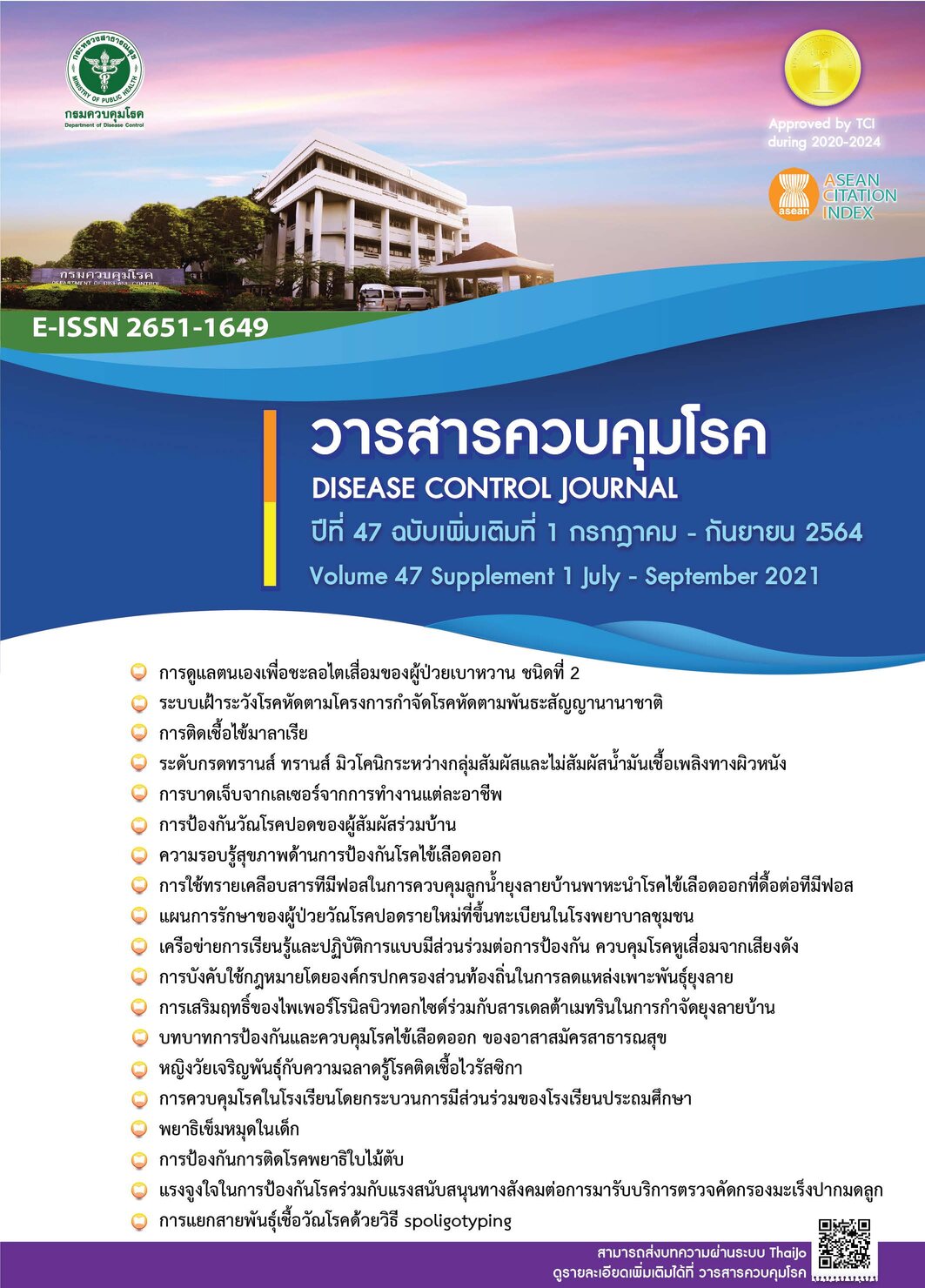Development of Learning Network and Participatory Action for Noise - induced Hearing Loss Prevention in Steel Factory
DOI:
https://doi.org/10.14456/dcj.2021.67Keywords:
Creating network of participatory learning, prevention and control of hearing loss caused by noise, steel industrial factoryAbstract
The objective of this research is to study the cooperative action process that creates a network and the effect of outputs from the network on reducing the risk of occupational noise-induced hearing loss in industrial factories by using a participatory action research model. The research process consists of 4 phases: 1: Preparedness of administrators, factory owners, labour union, and field researchers; 2: Problem solving/development operation; 3: Result evaluation at the end of the project; 4: Return project information to the target groups, community and society. We recruited a total 27 participants from executives, employees, and labour unions members as a target group. Data were collected by the research team. The quantitative data was analysed by quantitative method using statistics, percentages, mean, standard deviation, McNemar test, and Wilcoxon Matched Pairs Signed-Ranks Test. The qualitative data was validated by triangulation technique and analysed by content analysis. The research results are as follows: (1) The network formation process initiated by the executives, sufferers, and labour unions with then idea to reduce the loud noise from the sources inside the factory that are harmful to oneself and colleagues. (2) All of Employees working in noisy areas, office employees who have been exposed to loud noise for a short time, and outsiders entering the factory area wear 100% of PPE devices; 10 sections reduced the noise level to less than 85 dB(A); no incidence of hearing loss caused by loud noise. (3) There are 13 success stories and KAIZEN 49 items which are innovations to reduce the noise. (4) Hearing performance examination results of employees before and after the network was launched showed a statistically significant difference. It can be concluded that learning and cooperative operation network can help the hearing performance of employees and it is not inferior than without the network. (5) The network members accepted the network at a high level in all aspects such as structure, system, participation, knowledge exchange, sustainability, follow-up, and satisfaction. (6) Representatives from 16 large industrial factories and 10 government agencies participated in publishing the research meeting and expressed an interest in applying the research results.
Downloads
References
Division of Occupational and Environmental Diseases. Occupational medicine tools manual. 3rd ed. Nonthaburi: Division of Occupational and Environmental Diseases; 2013.
National Occupational Research Agenda. Hearing loss. [Internet]. 2001 [cited 2020 May 8]. Available from: http://www.cdc.gov/niosh/nrhear.html
Social Security Office. Workmen's Compensation Fund [Internet]. [cited 2020 may 8]. Available from: http://www.sso.go.th/knowledge/workmid2.asp
Adulyadej B. Compensation Act of 2018. New South Wales. 2018:135;1-12.
Division of Occupational and Environmental Diseases. Report on the situation of diseases and health hazards from occupation and environment in 2016 [Internet]. Nonthaburi. 2017 [cited 2017 Sep 16]. 66 p. Available from: http://envocc.ddc.moph.go.th/uploads/situation/01_envocc_situation_59.pdf
Health Area 6, Ministry of Public Health. Information on the situation of occupational diseases and the environment in 2017. Chonburi: Health Area 6; 2017.
Raj Pracha Samasai Institute. Report of hearing vulnerability examination results. Samut Prakan: Raj Pracha Samasai Institute; 2015.
Teangkumdee S, Nuntapanich N. The study of hearing disorders for large steel manufacturing factories Samut Prakan Province. Samut Prakan: Raj Pracha Samasai Institute; 2019.
Criteria and methods for preparing hearing conservation measures in the workplace. Notification of the Department of Labor Protection and Welfare. Pub L 135. 134 Ngor Stat [Internet]. [cited 2017 Sep 16]. 5 p. Available from: https://www.gem-thai.com/wp-content/uploads/2019/03/02.pdf
Department of Industrial Works. Industrial factory statistics in 2016. Ministry of Industry. [Internet]. Bangkok. [cited 2020 Jul 6] Available from: http://www.diw.go.th/hawk/content.php
Erwin W. Participation Management: Concept Theory and Implementation. Atlanta: Georgia State University; 1976.
Phongphit S. Network: Tactics for a strong community a strong community. Bangkok: Learning Institute for Everyone; 2005.
Chuenmuang A. Participatory reduction of noise exposure among employees in discotheques and surrounding at Khaosan Road area, Phranakorn District, Bangkok [Thesis]. Pathum Thani: Thammasat University; 2015. 1-63 p.
Thongsai P. The Effects of Participatory Learning Program in The Development Behaviors Employees for Occupational Hearing Loss Prevention in Factories, Lopburi Province. In: Division of Occupational and Environmental Diseases. Occupational & Environmental Health: Now & Beyond AEC 2015; Mar 13-15; Prince Palace Hotel, Bangkok. Bangkok: 2015. P. 1-116.
Inthawong J, Rheanpumikankit S, Kamkaew K, Ratanamad A, Kanthong W. Nursing system Development for Noise-induced Hearing Loss Prevention in the Factories. The Journal of Faculty of Nursing Burapha University [Internet]. 2011 [cited 2020 may 8]; 19(4):73-82. Available from: https://drive.google.com/file/d/13tP1DFAvhNnUr2nQ4bkoBFGXlvBW4I9H/view
Jansee N. The result of using participation model over improving health behaviors to prevent noise induse hearing loss in KN-Stream Industrial workers, Kaolieo, Nakhon Sawan [Thesis]. Nakhon Sawan: Nakhon Sawan Rajabhat University. 139 p.
The Association of Occupational and Environmental Diseases of Thailand. Guideline for Standardization and Interpretation of Audiometry in Occupational Health Setting 2015 [Internet]. Bangkok. [cited 2020 May 9] Available from: https://www.summacheeva.org/book/audiometry
Yoddumnern-Attig B, Tangchonlatip K. Qualitative Data Analysis: Data Handling, Interpretation And finding meaning. Nakhon Pathom: Institute for Population and Social Research, Mahidol University; 2009.
Roopngam Y. Participation on Bureaucratic Reform of the Bureau of the Budget. [Thesis]. Bangkok: National Institute of Development Administration; 2002. 73 p.
Chareonwongsak K. Network Management: Strategic importance to the success of education reform. Bangkok: Success Media; 2000.
Rittideah D, Kalampakorn S, Suwan-ampai P. Effects of applying the planned behavior theory and feedback on noise protection behavior among workers in petrochemical industry, Rayong Province. Journal of Public Health Nursing. 2017;33:90-109.
Downloads
Published
How to Cite
Issue
Section
License
Articles published in the Disease Control Journal are considered as academic work, research or analysis of the personal opinion of the authors, not the opinion of the Thailand Department of Disease Control or editorial team. The authors must be responsible for their articles.






